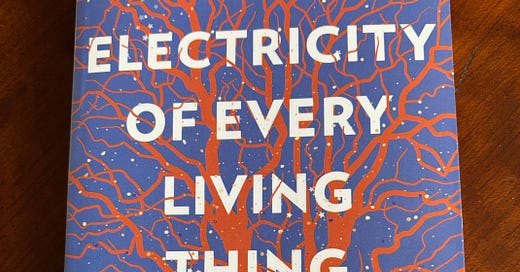I haven’t done a book recommendation in awhile so I thought I’d share my recent very interesting read. Another book by the same author, Katherine May, was recommended to me and when I went to find “Wintering” on Amazon, the cover and title of this book caught my eye. I have come to understand that science tells us we are vibrational beings and that every living thing has an “electricity” that interacts with our own. I wasn’t sure what the book would be about, but when I read the description, I thought it would be an interesting topic to dig into: “A life-affirming exploration of wild landscapes, what it means to be different and above all, how we can all learn to make peace with our own unquiet minds.”
Katherine May is a best-selling British author and avid lover of the great outdoors. This book chronicles her desire to walk the 630-mile South West Coast Path. As she set out to make plans to undertake the walk over a few months, she happened to hear a radio program where the guest was a woman who had discovered she was on the autism spectrum. As Katherine tuned in, she felt the woman was describing Katherine herself and why she was having trouble coping with everyday life. As she embarked on conquering the rugged coastline terrain, she also sought to come to terms with her neurodiversity.
I became curious about the idea that we all have characteristics and behaviors that may somehow fit within the autism spectrum. For instance, one of the characteristics that can be a symptom of ASD is a photographic memory. I have had such a memory since I was a child. My mother told me her brother had it as well. When the book mentioned this anomaly, I was intrigued. Are there things in our personalities that we always just considered quirks of character that really do signal some level of neurodiversity?
As Katherine explored that coastline path, some of which was very rugged and weather conditions in coastal Great Britain being what they are, she learned more about how her own brain worked and the things about herself that caused her to struggle with motherhood, societal expectations, and her responses to life situations. She describes this part of her journey of discovery about herself this way: “For me, there are habits to be unlearned and new ones to be acquired. I’m left with a strange sense of trying to understand something that’s invisible to me. I feel like I’m investigating a set of absences in my life, and trying to see them through the lens of other people’s half-remembered, half perceived responses. It’s full of loss. It’s the end of my life story, the comforting, consistent one I’ve told myself so far. I’m unpicking it. I have to reset the seams again.”
Photo credit: hillwalktours.com
The walking/hiking was cathartic and yet challenging for her. “When I took up walking, I accidentally found another way to meditate. The gifts are the same. My brain alights on the problems that walking throws up – finding my route, managing aching legs, hunger, thirst – and while my conscious self is otherwise occupied, other processes grind on quietly beneath…. Without walking, I don’t think I would have ever realized what I am. I had never made room to realize it before.” She wanted to make sense of herself and how she fit into her world and the walking became a time and space to do just that.
As she studied her own feelings and responses, she sought a diagnosis, not to put a label on herself or to seek any particular treatment, but to understand why she struggled in certain areas of her life and also to embrace the positive elements that can come with such a diagnosis. Her doctor confirmed that likely she has a form of autism. Knowing and accepting has helped her learn to function better in her family, in her job at a university and in navigating social settings. She shared her diagnosis with the people who mattered. She wrote the book to help others realize why life can seem overwhelming at times for some of us and offer some tools for self-discovery.
Photo Credit: absoluteescapes.com
We may all be on “the spectrum” somewhere. I’m not too worried that my photographic memory is something bigger than an inherited quirk of my brain. But this book helped me take a harder look at my own personality traits and come to terms with my own responses to life experiences. I find the study of the human brain a fascinating topic to explore. If you do as well, I think you will enjoy “The Electricity of Every Living Thing.” And even if brain study is not of interest, you might find Katherine’s walking journey something to which you can relate. Katherine May is an articulate storyteller, embracing humor and honesty in her writing. Maybe now I will read “Wintering” as I first set out to do.
Photo credit: The author, Katherine May by Elise Loehnen







Thank you for this very interesting topic Cathey! The percentage of children with ASD has increased considerably, so as teachers we have to be well informed to use the best strategies with our students.
Cathey, thanks for this interesting perspective. Looks like it’s another couple of books I should have in my pile! Loved the photos of the south coast of England. Aww hugs.